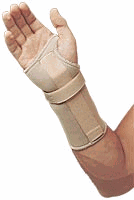Home » Medical Supplies & Equipment » Wrist Braces & Wrist Supports » Wrist Braces & Wrist Supports
Wrist Braces & Wrist Supports

Carpal Tunnel Brace w/out Dorsal Stays
Retail Price: $33.49
Your Price: $26.79
 Unit: single
Unit: single

Carpal Tunnel Brace with Dorsal Wrist Stay
Retail Price: $38.77
Your Price: $31.01
 Unit: single
Unit: single

Elastic Wrist Support with Palm Stay
Retail Price: $10.87
Your Price: $8.69
 Unit: single
Unit: single
The human wrist is one of the most complex joints of the body. It serves as the junction between the arm and the hand. In the wrist, the ulna and radius bones of the arm meet up with the eight tiny carpal bones of that rest between the hand and the arm. These carpal bones are what allow the wide range of motion of the wrist. Unlike the hinge joint of the knee or elbow, or even the ball and socket joint in the shoulder, that allow a limited pattern of movement, the multiple junctures with the carpal bones mean that the wrist is capable of moving in almost any direction. While this can be a boon for anyone who daily uses their hands, it can also be a bane for those suffering from wrist pain. With the myriad of joints, muscles, tendons, ligaments and bones in the wrist, risk of injury is high. After which a wrist support brace must be worn to prevent further damage.
The patient must be ready with a series of questions and answers when visiting his physician about wrist pain. When awaiting an office visit, if there is considerable swelling or difficulty in moving the wrist, the patient should wear a supporting wrist brace to keep the hand and wrist still. The doctor will likely ask if the patient remembers a sudden injury or if the pain came on slowly over several weeks or months. Severity of pain and range of motion will also be asked of the patient. After a thorough history of the injury has been taken, the doctor might order diagnostic tests such as X-rays to look for broken bones or an MRI to scan for nerve and tissue damage.
Results of injury typically are fractures or sprains. A fracture will call for either a splint or a cast to be fitted to the patient's wrist, but if no fracture is seen, then, the practitioner is likely to just ask the patient to wear a wrist brace support or a removable splint to keep the joint immobile until it has fully healed. If the sprain is very mild, though, the patient might not need a wrist support brace . Since only the doctor will be able to discern the need for a support support brace for the wrist, and the type, the patient must always ask his physician when deciding on whether or not to wear a wrist support brace .
Pain in the wrist that does not stem from a single incident could point toward arthritis, tendinitis, or carpal tunnel syndrome. All of these are chronic conditions that require the proper long-term wrist brace support to give the patient the fullest life possible. Arthritis is an inflammation of the joints, while tendinitis is pain from swollen tendons. Carpal tunnel syndrome is a form of repetitive strain that results from constant pressure on one of the major nerves of the wrist. In all of these cases, keeping the joint still usually coincides with relief from pain. A doctor might ask the patient to wear a brace support for the wrist either at night only or throughout the day.
No matter the cause, the decision to wear a wrist brace support must be made with the advice of the patient's physician, who is the only one to know which form of treatment for wrist pain is best.
Whatever your requirements, you can find what you are looking for today in our online inventory. If you have any questions or need assistance, call us toll-free at 1-877-706-4480. Our staff is ready to assist you.














